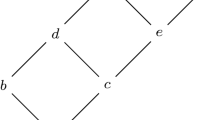Abstract
Binary relations induced from aggregation operations on a bounded lattice have received more and more attention. In this paper, we investigate binary relations induced from a quasi-overlap function and a quasi-grouping function on a bounded lattice L, respectively. At first, we provide a new approach to generate binary relations by a lattice-valued quasi-overlap function and a lattice-valued quasi-grouping function. In this new approach, we get rid of the restriction of the Intermediate Value Theorem, which is the main tool in the case \(L=[0,1]\). Then we discuss the connections between the induced binary relations and the natural order on L. Finally, we demonstrate the conditions under which the binary relations can become a reflexive, anti-symmetric, transitive relation as well as a partial order. In particular, we explore the binary relations induced from two classes of special quasi-overlap (resp. grouping) functions, which are generated by a quasi-pseudo-automorphism and a \(0_L\), \(1_L\)-aggregation function, respectively.
Similar content being viewed by others
Notes
A binary operator T: \(L\times L\longrightarrow L\) is called a t-norm (Bedregal et al. 2012) on a bounded lattice L if it is commutative, associate, increasing and \(1_L\) is the neutral element. In addition, a t-norm T is said to be positive provided that \(T(x,y)=0_L\) implies \(x=0_L\) or \(y=0_L\).
References
Aşıcı E (2017) An order induced by nullnorms and its properties. Fuzzy Sets Syst 325:35–46
Aşıcı E (2018) On the properties of the \(F\)-partial order and the equivalence of nullnorms. Fuzzy Sets Syst 346:72–84
Aşıcı E (2019) An extension of the ordering based on nullnorms. Kybernetika 55:217–232
Bedregal B, Beliakov G, Bustince H, Fernandez J, Pradera A, Reiser R (2012) Negations generated by bounded lattices \(t\)-norms. Proc IPMU 2012 Part III CCIS 229:326–335
Bedregal B, Dimuro GP, Bustince H, Barrenechea E (2013) New results on overlap and grouping functions. Inf Sci 249:148–170
Bustince H, Fernández J, Mesiar R, Montero J, Orduna R (2009) Overlap index, overlap functions and migrativity. In: Proceedings of IFSA/EUSFLAT Conference, pp 300–305
Bustince H, Fernández J, Mesiar R, Montero J, Orduna R (2010) Overlap functions. Nonlinear Anal 72:1488–1499
Bustince H, Pagola M, Mesiar R, Hüllermeier E, Herrera F (2012) Grouping, overlap, and generalized bientropic functions for fuzzy modeling of pairwise comparisons. IEEE Trans Fuzzy Syst 20:405–415
Dimuro GP, Bedregal B (2014) Archimedean overlap function: the ordinal sum and the cancellation, idempotency and limiting properties. Fuzzy Sets Syst 252:39–54
Dimuro GP, Bedregal B (2015) On residual implications derived from overlap functions. Inf Sci 312:78–88
Dimuro GP, Bedregal B, Bustince H, Asiáin MJ, José M, Mesiar R (2016) On additive generators of overlap functions. Fuzzy Sets Syst 287:76–96
Dimuro GP, Bedregal B, Bustince H, Jurio A, Baczyński M, Miś K (2017) \(QL\)-operations and \(QL\)-implication functions constructed from tuples \((O, G, N)\) and the generation of fuzzy subsethood and entropy measures. Int J Approx Reason 82:170–192
Ertuğrul Ü, Kesicioğlu MN, Karaçal F (2016) Ordering based on uninorms. Inf Sci 330:315–327
Fang BW, Hu BQ (2019) Semi-\(t\)-operators on bounded lattices. Inf Sci 490:191–209
Karaçal F, Kesiciŏglu MN (2011) A \(T\)-partial order obtained from \(t\)-norms. Kybernetika 47:300–314
Kesicioğlu MN, Şamlı E (2020) Ordering based on uni-nullnorms. J Intell Fuzzy Syst 39:645–663
Kesicioğlu MN, Karaçal F, Mesiar R (2015) Order-equivalent triangular norms. Fuzzy Sets Syst 268:59–71
Lu J, Wang KY, Zhao B (2018) Equivalence relations induced by the \(U\)-partial order. Fuzzy Sets Syst 334:73–82
Ma Z, Wu W-M (1991) Logical operators on complete lattices. Inf Sci 55:77–97
Mitsch H (1986) A natural partial order for semigroups. Proc Am Math Soc 97:384–388
Paiva R, Palmeira E, Santiago R, Bedregal B (2021) Lattice-valued overlap and quasi-overlap functions. Inf Sci 562:180–199
Qiao JS (2019a) On binary relations induced from overlap and grouping functions. Int J Approx Reason 106:155–171
Qiao JS (2019b) On distributive laws of uninorms over overlap and grouping functions. IEEE Trans Fuzzy Syst 27(12):2279–2292
Qiao JS (2021a) Overlap and grouping functions on complete lattices. Inf Sci 542:406–424
Qiao JS (2021b) Constructions of quasi-overlap functions and their generalized forms on bounded partially ordered sets. Fuzzy Sets Syst. https://doi.org/10.1016/j.fss.2021.03.004
Qiao JS (2022) On discrete quasi-overlap functions. Inf Sci 584:603–617
Qiao JS, Hu BQ (2018a) On multiplicative gennerators of overlap and grouping functions. Fuzzy Sets Syst 332:1–24
Qiao JS, Hu BQ (2018b) The distributive laws of fuzzy implications over overlap and grouping functions. Inf Sci 438:107–126
Wang HW (2020) Constructions of overlap functions on bounded lattices. Int J Approx Reason 125:203–217
Wang YT, Hu BQ (2021) On ordinal sums of overlap and grouping functions on complete lattices. Fuzzy Sets Syst. https://doi.org/10.1016/j.fss.2021.04.019
Wang YT, Hu BQ (2022) Constructing overlap and grouping functions on complete lattices by means of complete homomorphisms. Fuzzy Sets Syst 427:71-95
Zhu K, Wang J, Yang Y (2021) New results on the modularity condition for overlap and grouping functions. Fuzzy Sets Syst 403:139–147
Acknowledgements
The authors are thankful to the anonymous referees for their constructive comments and suggestions.
Author information
Authors and Affiliations
Corresponding author
Additional information
Communicated by Regivan Hugo Nunes Santiago.
Publisher's Note
Springer Nature remains neutral with regard to jurisdictional claims in published maps and institutional affiliations.
This work is supported by the National Natural Science Foundation of China (Nos. 12071033, 11871097) and Beijing Institute of Technology Science and Technology Innovation Plan Cultivation Project (No. 2021CX01030)
Rights and permissions
Springer Nature or its licensor holds exclusive rights to this article under a publishing agreement with the author(s) or other rightsholder(s); author self-archiving of the accepted manuscript version of this article is solely governed by the terms of such publishing agreement and applicable law.
About this article
Cite this article
Sun, Y., Pang, B. & Zhang, SY. Binary relations induced from quasi-overlap functions and quasi-grouping functions on a bounded lattice. Comp. Appl. Math. 41, 340 (2022). https://doi.org/10.1007/s40314-022-02048-1
Received:
Revised:
Accepted:
Published:
DOI: https://doi.org/10.1007/s40314-022-02048-1




